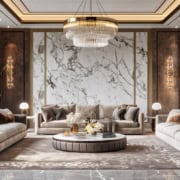Interior Design: Transforming Spaces with Style and Purpose
Introduction
Interior design goes beyond just placing furniture or selecting paint hues – it is the art and science of turning a space’s interior into a functional work of beauty and art. Good design can significantly impact how we feel, perform, and live in a place, be it a small studio apartment or a gigantic commercial structure.
What is Interior Design?
Designing the inside of a home, office or any other place is an interior design. It is the combination of imagination, technology, and creativity to organize and decorate a home. It includes color selection, lighting, planning of space, selection and arrangement of materials, equipment and furniture, and to create an environment that corresponds to the needs and lifestyle of the people who live in the space.
As opposed to internal decorations which are more of aesthetics, interior design looks into the functionality and structure of a particular space. It involves the arrangement of areas to achieve flow, harmony, safety, balance, accessibility, efficiency, and ease.
The Job Duties of an Interior Designer
An interior designer is a person who decorates and designs interiors and spaces according to the specific needs of the clients in relation to the architecture of the building. The interior designers are in collaboration with the architects, engineers, and contractors because every aspect such as lighting, flooring, and furnishings should be cohesive in the vision of the project and should be precisely defined.
Here are the most salient duties an interior designer tends to:
- Designing space plans and layouts
- Choosing furnishings, colors, and materials
- Planning lighting and sound control
- Adhering to safety codes and laws
- Controlling schedules and expenditures
The Importance of Interior Design
Enhances Efficiency
Well designed should function for the user, and not otherwise. It should capture, optimize space, improve movement, and make sure every zone is purposeful.
Changes Environment Adding Relaxation
Emotions can be positively and negatively affected by light and color. Warm colors are very inviting, while natural light makes people feel better. Interior designers work with these to make spaces pleasant to live or work in.
Portrays Personal Preferences Or Business Branding
Interior designers work for broad expression of personality and lifestyle in homes. In commercial buildings, it defines brand identity and shapes customer perceptions of the organization.
Increases Value
If a property has good design, its value will increase. It becomes attractive to buyers or tenants and saves them from expensive renovations in the future.
Important Aspects Of Interior Design
Space.- Being able to work with and allocate space is very important. Designers cope with both positive and negative space to work towards achieving balance.
Line.- Lines create and draw the eye towards patterns or movement. Vertical lines make one room feel tall and horizontal lines give the width to make it feel wider.
Form– Refers to the shape of the furniture and structures. It can either be geometric (sharp/ angular) or organic (natural/ flowing).
Light – Mood, function, and aesthetics are all in part affected by the presence of natural or artificial light.
Color.- Color is askey determiner in the setting of the tone for a particular room and has a psychological impact.
Texture.- Combining smooth and rough surfaces adds depth which improves visual appeal.
Pattern.- Patterns can be helpful in terms of drawing the attention towards something or away from something in a given space.
Recent Innovations In Interior Design
Minimalism.– There are no loose ends to take care of which makes having clean lines and neutral tones satisfying.
Biophilic Design.- The use of plants, natural light, and organic materials help bring the outside nature in.
Sustainable Design.- The use of non eco friendly materials and energy efficient solutions does not exist.
Smart Homes.- These homes use technology for better ease convenience, control, and security.
Mixing Old And New.– Using vintage styles and contemporary adds a personal touch.
Conclusions
Interior design incorporates physical appearance, functionality, comfort, and artistic expression. Effective design considers the ergonomic aspects of the people using the space and enhances their lifestyle or brand image while evoking contentment with its thoughtful design and beauty.
Whether you want to redesign an entire house or simply redecorate a single room, working with an interior designer can be beneficial. The process of transforming surfaces such as walls and floors into captivating elements of identity is an imaginative endeavor that showcases one’s individuality.
See More Visit Website: Click Here

